The Social Light Field in Eco-Centric Outdoor Lighting
Abstract
1. Introduction
2. Background
2.1. Nighttime Walks
2.2. The Social Light Field
2.3. The Light Field
3. Method
3.1. Experiment Design and Procedure
3.2. Participants
3.3. Experimental Procedure
- Q1. The face is well-lit.
- Q2. The face looks friendly.
- Q3. The environment is well-lit.
- Q4. I feel comfortable in this lit environment.
3.4. Objective Measurements
3.5. Analysis
4. Results
5. Discussion
6. Conclusions
Author Contributions
Funding
Institutional Review Board Statement
Informed Consent Statement
Data Availability Statement
Acknowledgments
Conflicts of Interest
Appendix A
Appendix A.1
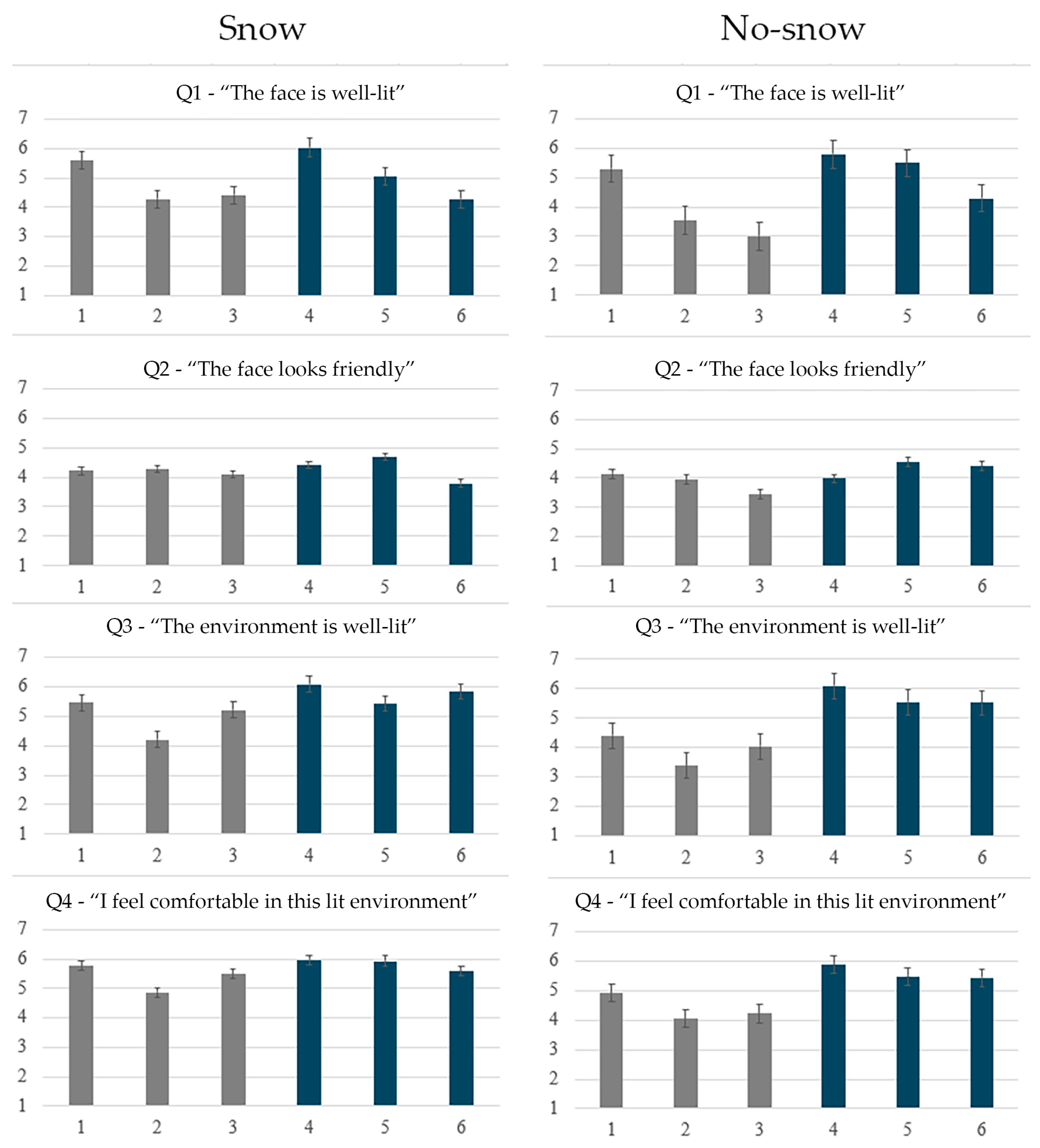
Appendix A.2
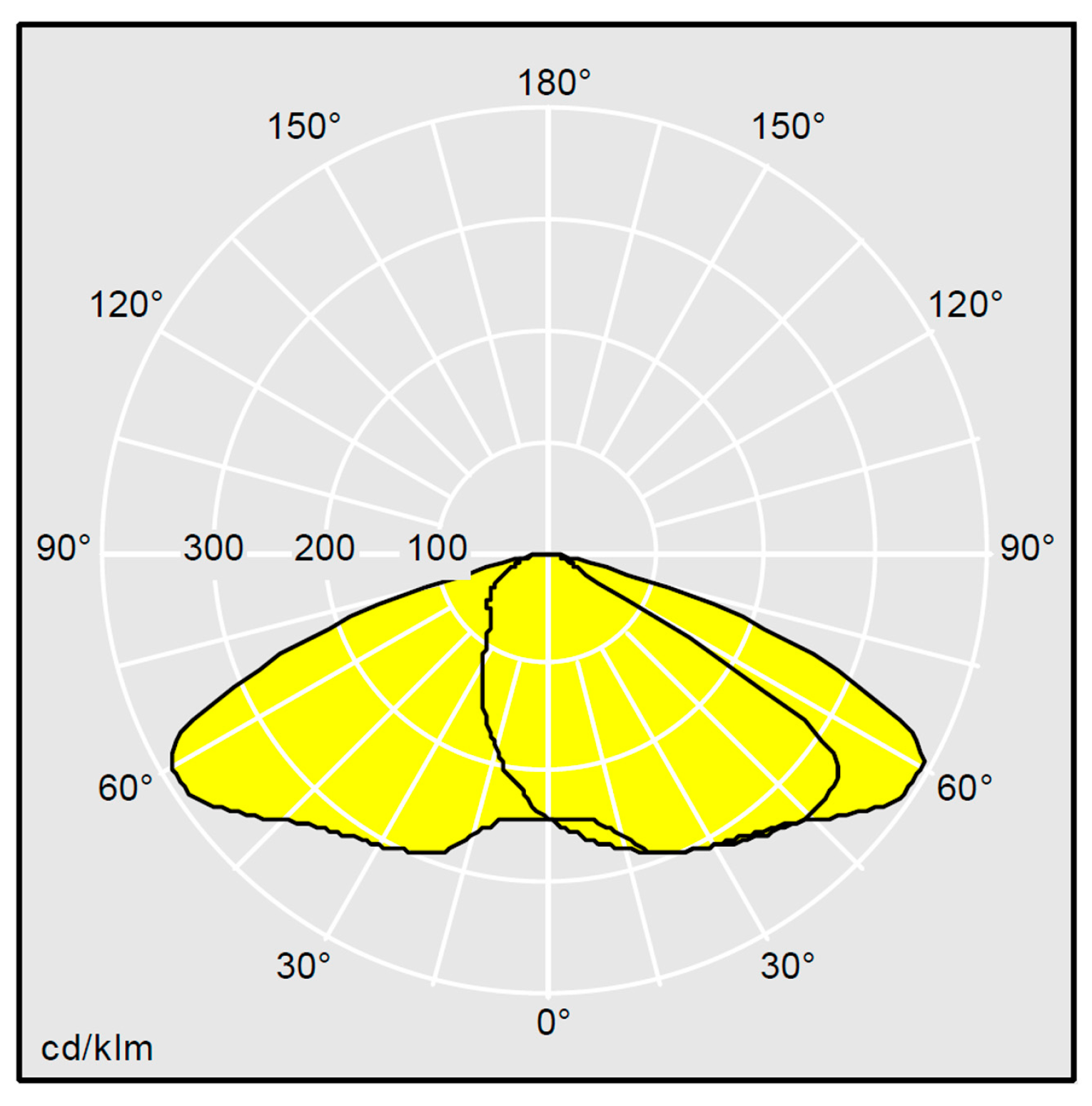
Appendix A.3
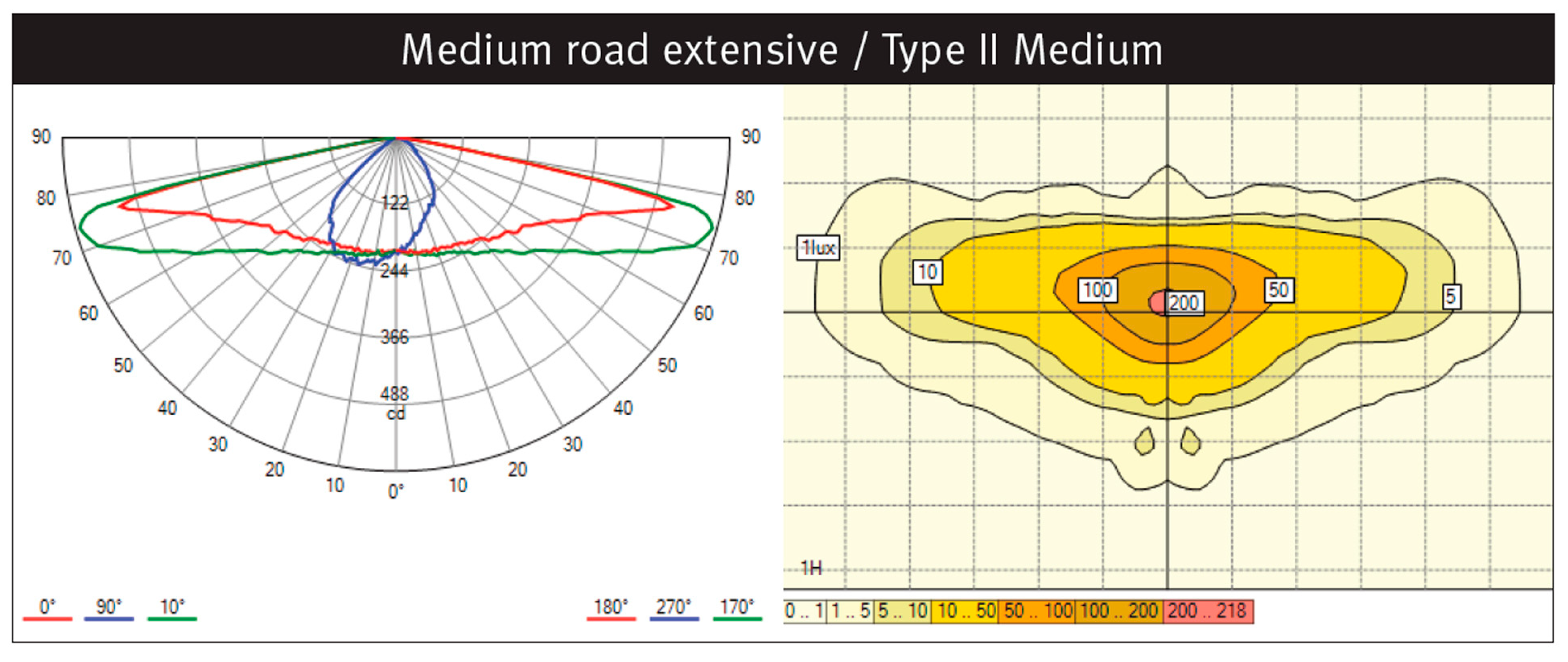
References
- Hölker, F.; Wolter, C.; Perkin, E.K.; Tockner, K. Light Pollution as a Biodiversity Threat. Trends Ecol. Evol. 2010, 25, 681–682. [Google Scholar] [CrossRef]
- Jägerbrand, A.; Spoelstra, K. Effects of Anthropogenic Light on Species and Ecosystems. Science 2023, 380, 1125–1130. [Google Scholar] [CrossRef] [PubMed]
- Owens, A.C.S.; Cochard, P.; Durrant, J.; Farnworth, B.; Perkin, E.K.; Seymoure, B. Light Pollution Is a Driver of Insect Declines. Biol. Conserv. 2020, 241, 108259. [Google Scholar] [CrossRef]
- Sanders, D.; Frago, E.; Kehoe, R.; Patterson, C.; Gaston, K.J. A Meta-Analysis of Biological Impacts of Artificial Light at Night. Nat. Ecol. Evol. 2020, 5, 74–81. [Google Scholar] [CrossRef]
- Stone, T. The Value of Darkness: A Moral Framework for Urban Nighttime Lighting. Sci. Eng. Ethics 2018, 24, 607–628. [Google Scholar] [CrossRef]
- Boyce, P.R. The Benefits of Light at Night. Build. Environ. 2019, 151, 356–367. [Google Scholar] [CrossRef]
- Edensor, T. Light Design and Atmosphere. Vis. Commun. 2015, 14, 331–350. [Google Scholar] [CrossRef]
- Porges, S.W. Polyvagal Theory: A Science of Safety. Front. Integr. Neurosci. 2022, 16, 871227. [Google Scholar] [CrossRef]
- Schroeter, V. Polyvagal Theory: Introduction for Somatic Psychotherapy. Clin. J. Int. Inst. Bioenerg. Anal. 2016, 26, 9–40. [Google Scholar] [CrossRef]
- Caminada, J.F.; van Bommel, W.J.M. New Lighting Criteria for Residential Areas. J. Illum. Eng. Soc. 1984, 13, 350–358. [Google Scholar] [CrossRef]
- Fotios, S.; Unwin, J.; Farrall, S. Road Lighting and Pedestrian Reassurance after Dark: A Review. Light. Res. Technol. 2015, 47, 449–469. [Google Scholar] [CrossRef]
- Fotios, S.; Johansson, M. Appraising the Intention of Other People: Ecological Validity and Procedures for Investigating Effects of Lighting for Pedestrians. Light. Res. Technol. 2019, 51, 111–130. [Google Scholar] [CrossRef]
- Fotios, S.; Raynham, P. Correspondence: Lighting for Pedestrians: Is Facial Recognition What Matters? Light. Res. Technol. 2011, 43, 129–130. [Google Scholar] [CrossRef]
- Johansson, M.; Pedersen, E.; Maleetipwan-Mattson, P.; Kuhn, L.; Laike, T. Perceived Outdoor Lighting Quality (POLQ): A Lighting Assessment Tool. J. Environ. Psychol. 2014, 39, 14–21. [Google Scholar] [CrossRef]
- Van Bommel, W. Road Lighting: Fundamentals, Technology and Application; Springer International Publishing: Berlin/Heidelberg, Germany, 2015; ISBN 978-3-319-11465-1. [Google Scholar]
- Bille, M.; Sørensen, T.F. An Anthropology of Luminosity: The Agency of Light. J. Mater. Cult. 2007, 12, 263–284. [Google Scholar] [CrossRef]
- Pont, S.C. Light: Toward a Transdisciplinary Science of Appearance and Atmosphere. Annu. Rev. Vis. Sci. 2019, 5, 503–527. [Google Scholar] [CrossRef]
- Gershun, A. The Light Field. J. Math. Phys. 1939, 18, 51–151. [Google Scholar] [CrossRef]
- Cuttle, C. Lighting Design—A Perception Based Approach, 1st ed.; Routledge: Oxfordshire, UK, 2015; ISBN 978-0-415-73197-3. [Google Scholar]
- Wåseth, H.I.; Zaikina, V.; Pont, S.C. Footpath Lighting: Optical, Visual and Perceptual Characteristics of the Social Light Field. LEUKOS 2025. accepted. [Google Scholar]
- Gehl, J. Cities for People; Island Press: Washington, DC, USA, 2010; ISBN 978-1-59726-573-7. [Google Scholar]
- Zaikina, V.; Matusiak, B.S.; Klöckner, C.A. Luminance-Based Measures of Contour Distinctness of 3D Objects as a Component of Light Modeling. LEUKOS 2015, 11, 31–45. [Google Scholar] [CrossRef]
- McMahon, E.; Isik, L. Seeing Social Interactions. Trends Cogn. Sci. 2023, 27, 1165–1179. [Google Scholar] [CrossRef]
- Yang, B.; Fotios, S. Lighting and Recognition of Emotion Conveyed by Facial Expressions. Light. Res. Technol. 2015, 47, 964–975. [Google Scholar] [CrossRef]
- Johnston, A.; Hill, H.; Carman, N. Recognising Faces: Effects of Lighting Direction, Inversion, and Brightness Reversal. Perception 1992, 21, 365–375. [Google Scholar] [CrossRef]
- Mury, A.A.; Pont, S.C.; Koenderink, J.J. Representing the Light Field in Finite Three-Dimensional Spaces from Sparse Discrete Samples. Appl. Opt. 2009, 48, 450–457. [Google Scholar] [CrossRef] [PubMed]
- Xia, L.; Pont, S.; Heynderickx, I. Light Diffuseness Metric Part 1: Theory. Light. Res. Technol. 2017, 49, 411–427. [Google Scholar] [CrossRef]
- Xia, L.; Pont, S.; Heynderickx, I. Light Diffuseness Metric, Part 2: Describing, Measuring and Visualising the Light Flow and Diffuseness in Three-Dimensional Spaces. Light. Res. Technol. 2017, 49, 428–445. [Google Scholar] [CrossRef]
- Cuttle, C. Lighting by Design; Architectural Press: Oxford, UK, 2003; ISBN 075065130X. [Google Scholar]
- Yu, C.; Eisemann, E.; Pont, S. Effects of Inter-Reflections on the Chromatic Structure of the Light Field. Light. Res. Technol. 2023, 55, 218–236. [Google Scholar] [CrossRef]
- Pont, S.C. Spatial and Form-Giving Qualities of Light. In Handbook of Experimental Phenomenology: Visual Perception of Shape, Space and Appearance; Wiley-Blackwell: West-Sussex, UK, 2013; Chapter 8; pp. 205–222. [Google Scholar]
- Michel, L. Light: The Shape of Space, 1st ed.; Wiley: New York, NY, USA, 1996. [Google Scholar]
- Yot, R. Light for Visual Artists Second Edition: Understanding and Using Light in Art & Design; Laurence King Publishing: London, UK, 2019. [Google Scholar]
- Zhang, F.; de Ridder, H.; Barla, P.; Pont, S. A Systematic Approach to Testing and Predicting Light-Material Interactions. J. Vis. 2019, 19, 11. [Google Scholar] [CrossRef]
- CEN EN 13201-2:2016; Road Lighting—Part 2: Performance Requirements. CEN: Brussels, Belgium, 2016.
- Jägerbrand, A.; Bouroussis, C. Ecological Impact of Artificial Light at Night: Effective Strategies and Measures to Deal with Protected Species and Habitats. Sustainability 2021, 13, 5991. [Google Scholar] [CrossRef]
- Gwiazdzinski, L. The Urban Night: A Space Time for Innovation and Sustainable Development. Artic.—J. Urban Res. 2015, 11, 1–14. [Google Scholar] [CrossRef]
- CEN EN 13201-3:2016; Road Lighting Part 3: Calculation of Performance. CEN: Brussels, Belgium, 2016.
- van Bommel, W. Lighting for Visual Satisfaction. In Encyclopedia of Color Science and Technology; Springer: Cham, Switzerland, 2023; pp. 1091–1098. ISBN 978-3-030-89862-5. [Google Scholar]
- Bommel, W. Topics Important for the Up-to-Date Interior Lighting Professional. Light Eng. 2020, 28, 4–22. [Google Scholar] [CrossRef]
- Kartashova, T. Structures of Physical and Visual Light Fields: Measurement, Comparison and Visualization. Ph.D. Thesis, Delft University of Technology, Delft, Netherlands, 2018. [Google Scholar] [CrossRef]
- Rahm, J.; Sternudd, C.; Johansson, M. “In the Evening, I Don’t Walk in the Park”: The Interplay between Street Lighting and Greenery in Perceived Safety. Urban Des. Int. 2020, 26, 42–52. [Google Scholar] [CrossRef]
- Rahm, J.; Johansson, M. Assessment of Outdoor Lighting: Methods for Capturing the Pedestrian Experience in the Field. Energies 2021, 14, 4005. [Google Scholar] [CrossRef]
- Davoudian, N.; Raynham, P. What Do Pedestrians Look at at Night? Light. Res. Technol. 2012, 44, 438–448. [Google Scholar] [CrossRef]
- Kuhn, L.; Johansson, M.; Laike, T.; Govén, T. Residents’ Perceptions Following Retrofitting of Residential Area Outdoor Lighting with LEDs. Light. Res. Technol. 2013, 45, 568–584. [Google Scholar] [CrossRef]
- Felder-Schmittbuhl, M.-P.; Buhr, E.D.; Dkhissi-Benyahya, O.; Hicks, D.; Peirson, S.N.; Ribelayga, C.P.; Sandu, C.; Spessert, R.; Tossini, G. Ocular Clocks: Adapting Mechanisms for Eye Functions and Health. Investig. Ophthalmol. Vis. Sci. 2018, 59, 4856–4870. [Google Scholar]
- Davidovic, M.; Djokic, L.; Cabarkapa, A.; Kostic, M. Warm White versus Neutral White LED Street Lighting: Pedestrians’ Impressions. Light. Res. Technol. 2019, 51, 1237–1248. [Google Scholar] [CrossRef]
- Lund, K.G.; Hvass, M. Socially Inclusive Lighting Design: Exploring a Method to Enhance Freedom of Movement for Marginalised Groups. IOP Conf. Ser. Earth Environ. Sci. 2024, 1320, 012029. [Google Scholar] [CrossRef]
- Peña-García, A.; Hurtado, A.; Aguilar-Luzón, M.C. Impact of Public Lighting on Pedestrians’ Perception of Safety and Well-Being. Saf. Sci. 2015, 78, 142–148. [Google Scholar] [CrossRef]
- Pena-Garcia, A.; Sedziwy, A. Optimizing Lighting of Rural Roads and Protected Areas with White Light: A Compromise among Light Pollution, Energy Savings, and Visibility. LEUKOS 2020, 16, 147–156. [Google Scholar] [CrossRef]
- Wänström Lindh, U. Light Shapes Spaces: Experience of Distribution of Light and Visual Spatial Boundaries. Ph.D. Thesis, University of Borås, Borås, Sweden, 2012. [Google Scholar]
- Villa, C.; Bremond, R.; Saint-Jacques, E. Assessment of Pedestrian Discomfort Glare from Urban LED Lighting. Light. Res. Technol. 2017, 49, 147–172. [Google Scholar] [CrossRef]
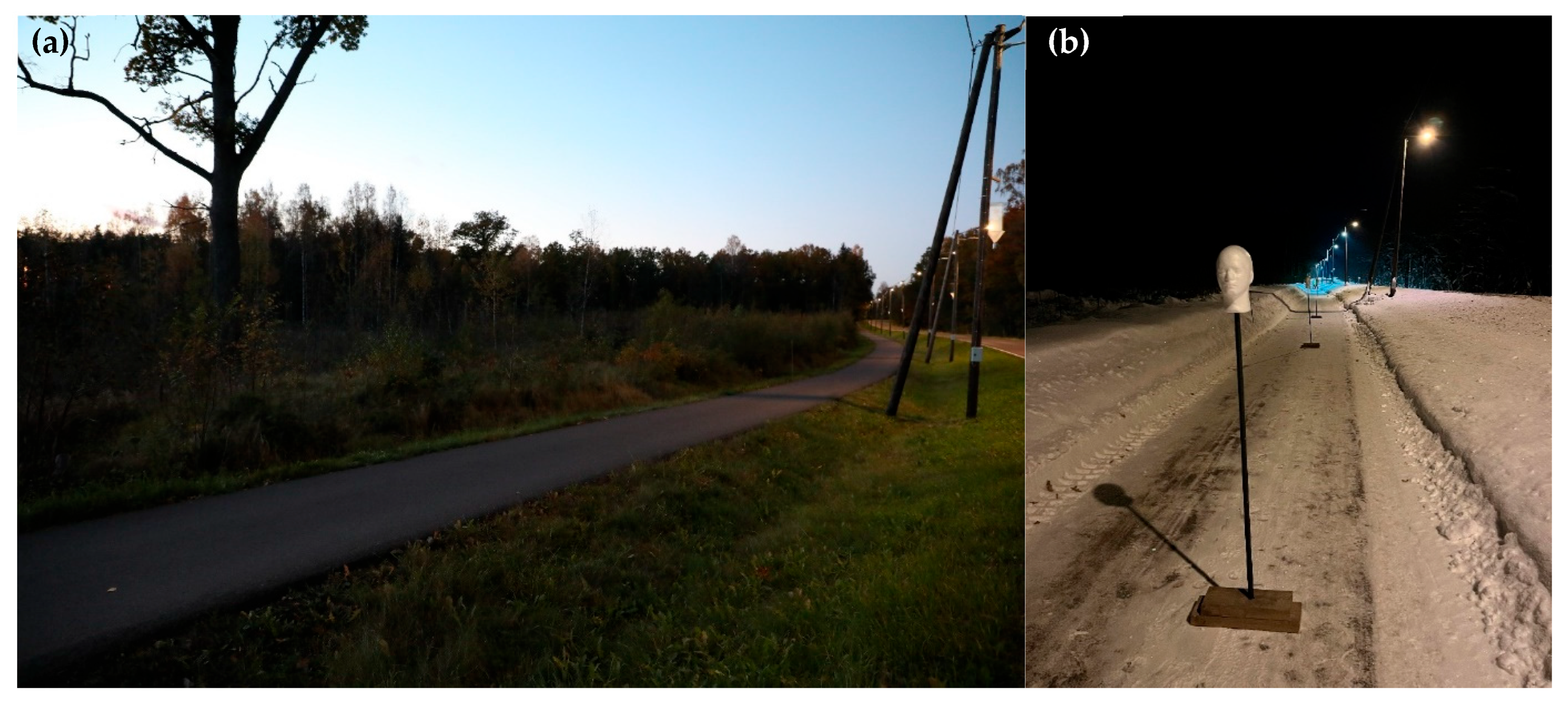
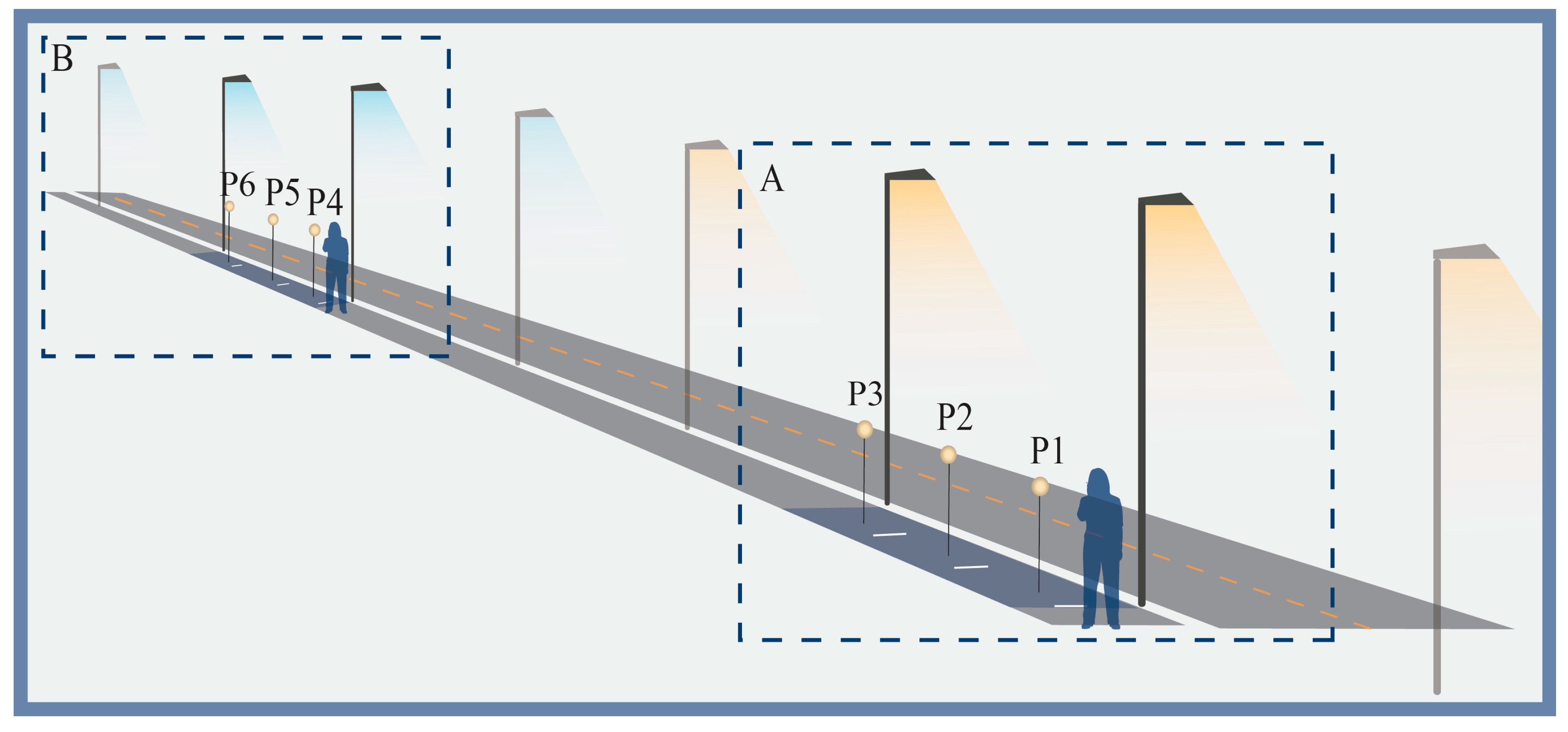
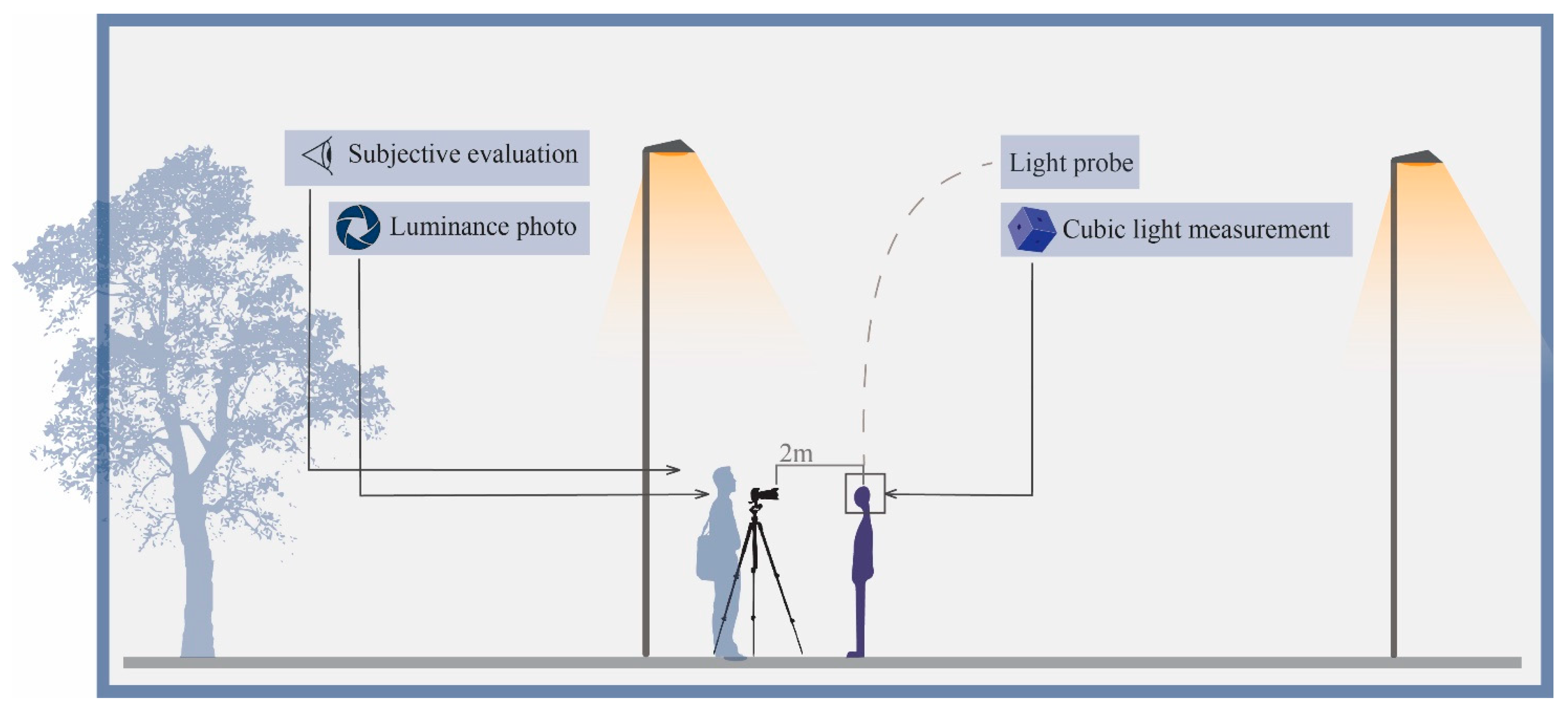
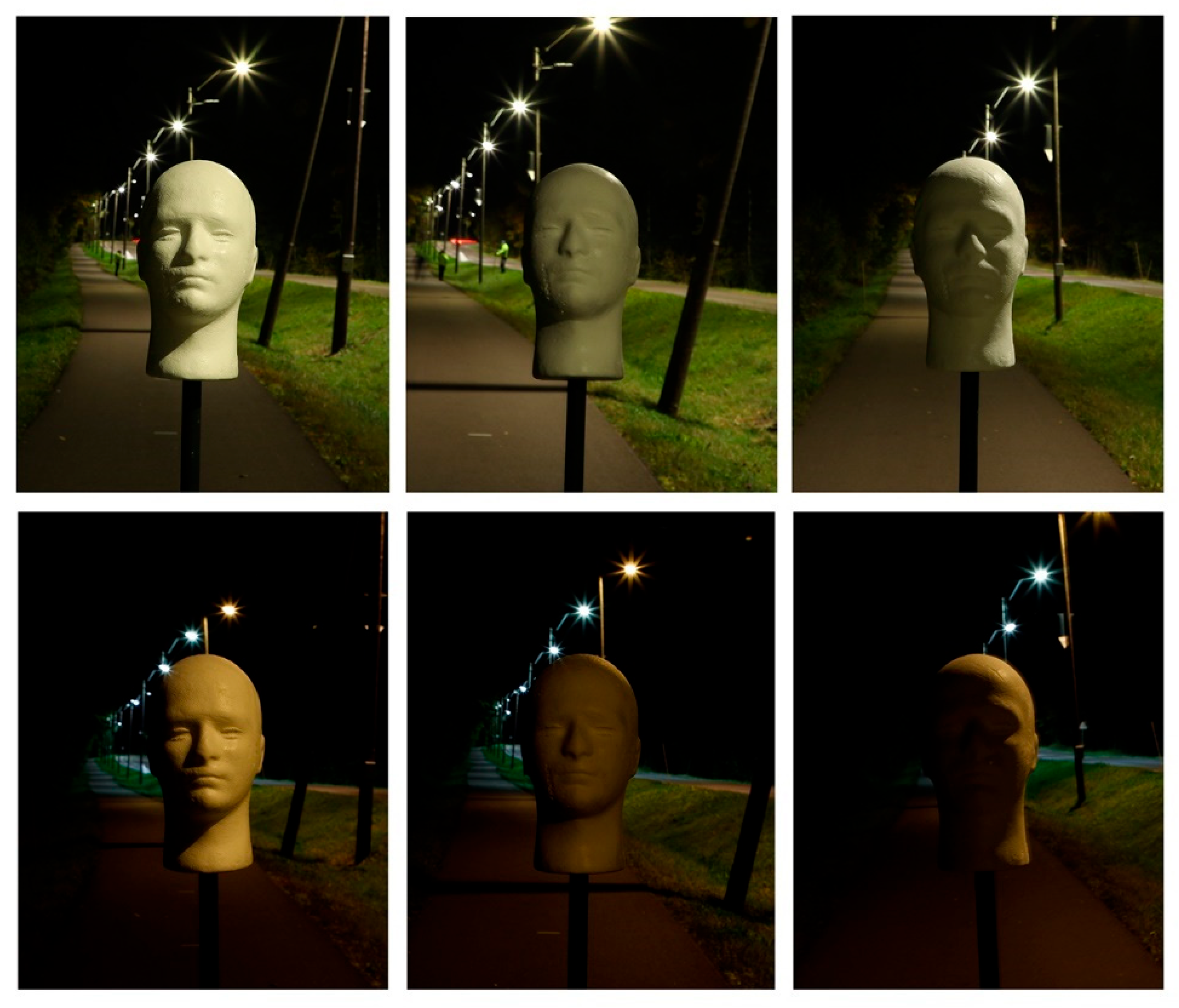

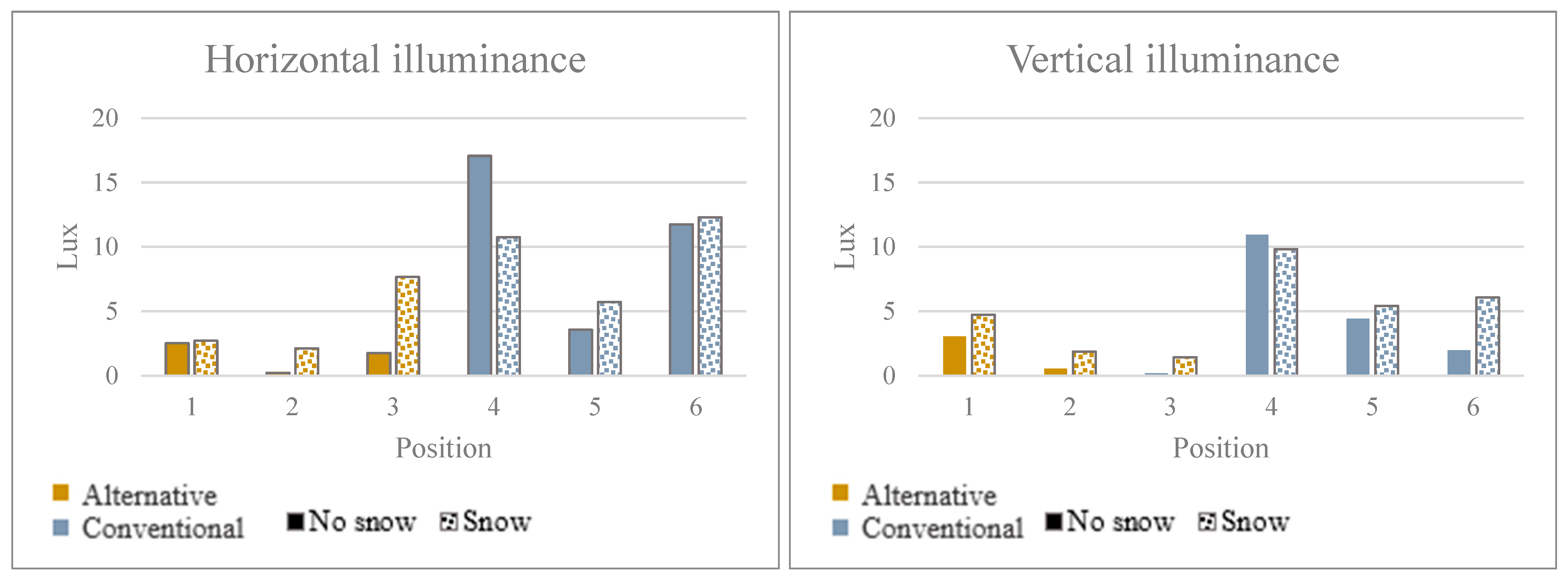
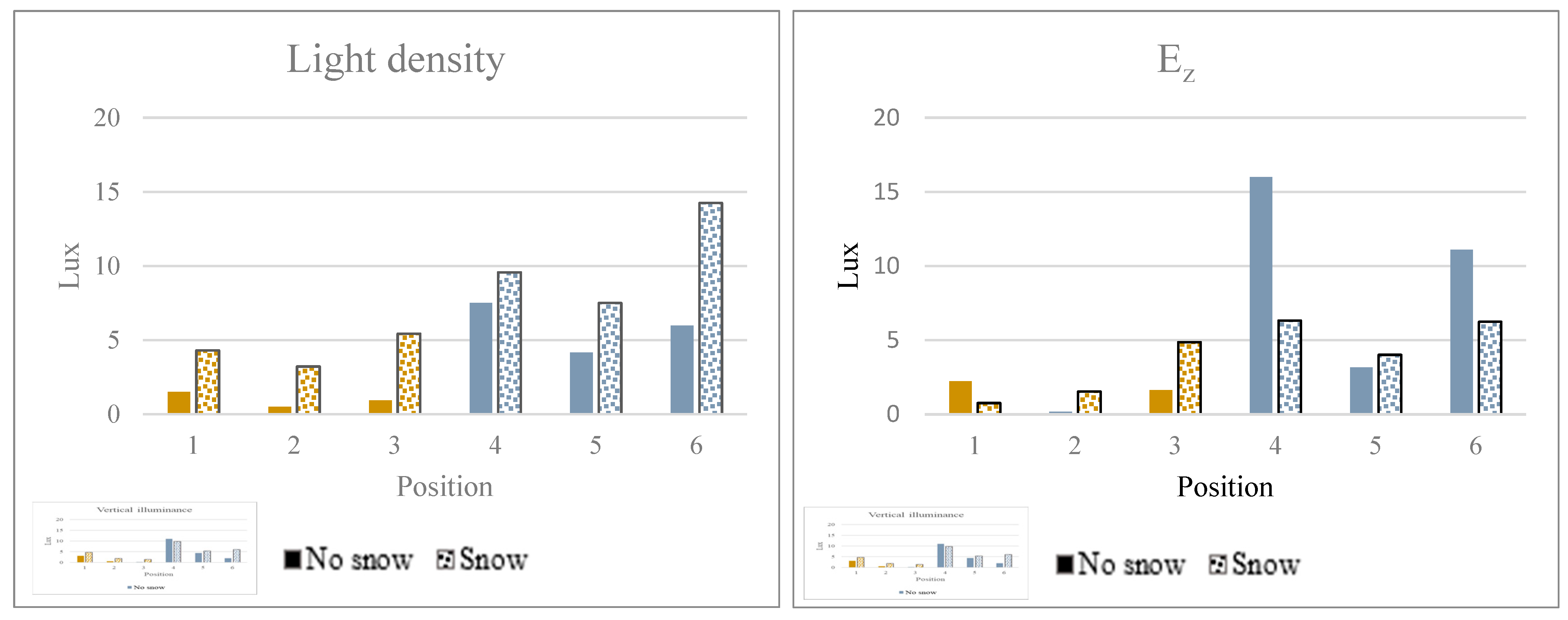
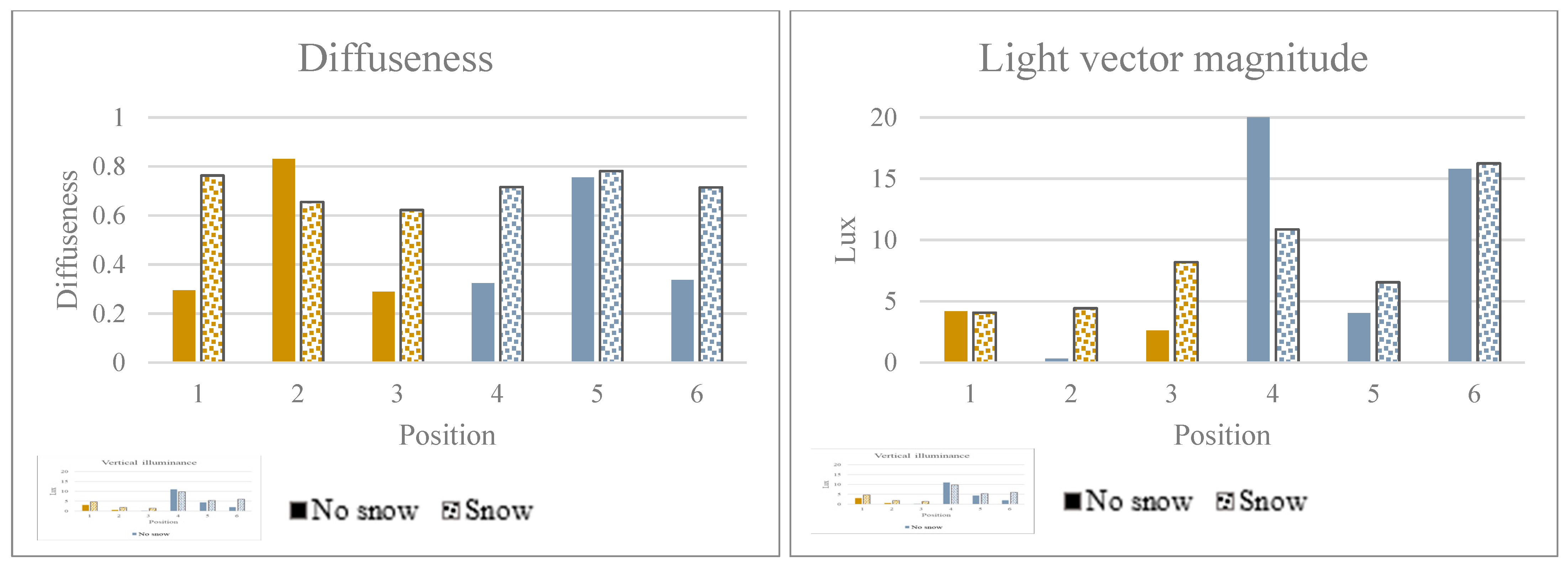
| Luminaire Type | CCT (K) | CRI | Lumen Output | Light Distribution | Power (W) | Distance Between Poles (m) | Height of the Pole (m) | Bracket Arm | Pole Distance from the Road |
|---|---|---|---|---|---|---|---|---|---|
| A. alternative | 2200 K | >70 | 4820 | Street comfort | 38 | 30 | 8 | 50 cm | 50 cm |
| B. conventional | 4000 K | >70 | 14,000 | Medium road | 132 | 30 | 9 | 100 cm | 50 cm |
| Predictor | Estimate | Std. Error | z-Value | Pr (>|z|) |
|---|---|---|---|---|
| Contrast face (0 = low, 1 = high) | −1.09643 | 1.00788 | −1.08800 | 0.27670 |
| Ev (0 = low, 1 = high) | 0.39245 | 0.05617 | 6.98700 | 0.00000 ***,1 |
| Diffuseness (0 = low, 1 = high) | 0.24914 | 0.57172 | 0.43600 | 0.66300 |
| Luminaire (0 = conventional, 1 = alternative) | 0.77724 | 0.38568 | 2.01500 | 0.04390 *,1 |
| Snow conditions (0 = snowy, 1 = non-snowy) | 0.77724 | 0.38568 | 2.01500 | 0.04390 *,1 |
| Predictor | Estimate | Std. Error | z-Value | Pr (>|z|) |
|---|---|---|---|---|
| Contrast face (0 = low, 1 = high) | 0.35575 | 1.03446 | 0.34400 | 0.73090 |
| Ev (0 = low, 1 = high) | 0.15029 | 0.05021 | 2.99300 | 0.00280 **,1 |
| Diffuseness (0 = low, 1 = high) | −1.26629 | 0.59283 | −2.13600 | 0.03270 *,1 |
| Luminaire (0 = conventional, 1 = alternative) | −1.48513 | 0.40163 | −3.69800 | 0.00020 ***,1 |
| Snow conditions (0 = snowy, 1 = non-snowy) | −1.03632 | 0.40755 | −2.54300 | 0.01100 *,1 |
| Predictor | Estimate | Std. Error | z-Value | Pr (>|z|) |
|---|---|---|---|---|
| Contrast face (0 = low, 1 = high) | −1.31866 | 1.09951 | −1.19900 | 0.23040 |
| Ev (0 = low, 1 = high) | 0.19513 | 0.05337 | 3.65600 | 0.00030 ***,1 |
| Diffuseness (0 = low, 1 = high) | −1.11815 | 0.61173 | −1.82800 | 0.06760 |
| Luminaire (0 = conventional, 1 = alternative) | −0.59953 | 0.41859 | −1.43200 | 0.15210 |
| Snow conditions (0 = snowy, 1 = non-snowy) | −1.24688 | 0.62586 | −1.99200 | 0.04630 *,1 |
Disclaimer/Publisher’s Note: The statements, opinions and data contained in all publications are solely those of the individual author(s) and contributor(s) and not of MDPI and/or the editor(s). MDPI and/or the editor(s) disclaim responsibility for any injury to people or property resulting from any ideas, methods, instructions or products referred to in the content. |
© 2025 by the authors. Licensee MDPI, Basel, Switzerland. This article is an open access article distributed under the terms and conditions of the Creative Commons Attribution (CC BY) license (https://creativecommons.org/licenses/by/4.0/).
Share and Cite
Wåseth, H.I.; Zaikina, V.; Pont, S. The Social Light Field in Eco-Centric Outdoor Lighting. Buildings 2025, 15, 3052. https://doi.org/10.3390/buildings15173052
Wåseth HI, Zaikina V, Pont S. The Social Light Field in Eco-Centric Outdoor Lighting. Buildings. 2025; 15(17):3052. https://doi.org/10.3390/buildings15173052
Chicago/Turabian StyleWåseth, Helga Iselin, Veronika Zaikina, and Sylvia Pont. 2025. "The Social Light Field in Eco-Centric Outdoor Lighting" Buildings 15, no. 17: 3052. https://doi.org/10.3390/buildings15173052
APA StyleWåseth, H. I., Zaikina, V., & Pont, S. (2025). The Social Light Field in Eco-Centric Outdoor Lighting. Buildings, 15(17), 3052. https://doi.org/10.3390/buildings15173052









